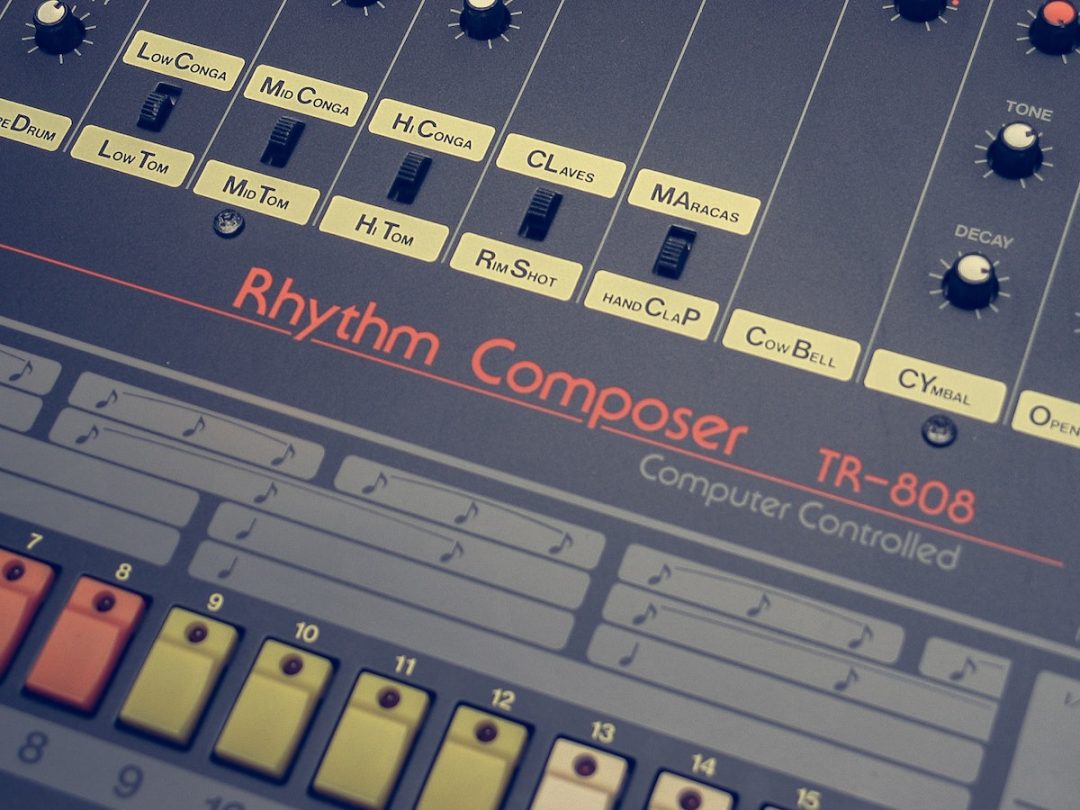The 808 is a defining feature of hip-hop (and its many sub-genres), pop, EDM, and modern electronic production. The original Roland drum machine took a while to catch on, but it would eventually revolutionize music.
What Is an 808 Beat?
When we use the term “808 beat,” it can refer to any electronic drum pattern that utilizes actual TR-808 sounds or any of thousands of modern sample recreations of them. And while the original hardware had a bank of analog-synthesized drum kit sounds, when we refer to 808 today, we’re almost exclusively talking about a particular flavor of sub bass.
So when you hear that speaker-rattling sub in many today’s music, that’s what 808 has become in modern production vernacular.
The Roland TR-808 & the History of 808 Beats
Roland released the TR-808 drum machine in 1980 and discontinued it three years later. It was a commercial flop, touted as a way to replace acoustic drums with analog synthesis. But the sounds themselves were entirely electronic-sounding, and nothing like an acoustic drum kit. Roland halted manufacturing after just 12,000 units, and the original machine was replaced by the TR-909 in 1983.
Despite not being a huge success up front, two of the earliest examples of 808 in popular music include Marvin Gaye’s “Sexual Healing” and Afrika Bambaataa & Soulsonic Force’s “Planet Rock” — both from 1982. The machine eventually gained a cult following, and today, the influence of the TR-808 drum machine on hip-hop and electronic music cannot be understated. That’s in large part due to its idiosyncratic sounds, but most importantly, it’s booming bass.
How to Make a Thumping 808 Beat
There’s a good chance you’re already using deep sub bass samples in your music, because it’s in the DNA of modern production. You can use 808 sub to emphasize kick hits and drops, or even tune it to create powerful melodic bass lines. There are thousands of 808 samples out there, many of which have been tuned, compressed, distorted, or otherwise manipulated to give them a unique sound suitable for a variety of music.
Find a Good Sample
Sample choice is one of the most important steps in making a great beat. You should consider the context first; if you have an instrumental loop or chord progression laid down, start auditioning 808 samples that make sense with the other sounds. Sample subscription services, like Splice, have thousands of these samples to try out.
Be Sure to Tune Your 808
The hallmark of an amateur production is an out-of-key 808. Samples come pre-tuned to a specific pitch, and if it’s out of the song’s key, it’ll sound terrible. There are different ways to tune a sample, but one of the most versatile ways is to drop it into a sampler that let’s you play the sample up and down a keyboard. With that, you can also make melodic 808 patterns.
EQ to the Bottom of the Mix
808s occupy the sub bass territory, with fundamentals typically between 30 and 60 Hz or so. You want to EQ to emphasize the power and fullness a great sub sample provides. It can get muddy quick, and it can also clash with your kick drum or synth bass, if you have one. When you’re EQ-ing sub, it’s namely about choosing a role for each low-end instrument and carving a space for it. In practice, that would mean letting the 808 take up the lowest end, and filtering the kick so that it doesn’t clash and provides more punch than sub information.
Increased Attack Time
Using the envelope controls on a sampler, increasing the attack time delays the peak level of the sub sample. What you hear is the punch of the kick drum first, and then a gradual build-up of subs. On the contrary, lots of producers want a hard-hitting sub with a fast attack that augments the kick drum. Be sure to play with decay, sustain, and release as well to get the perfect envelope that fits the track.
Know Your Frequencies
Remember that when you’re mixing on good monitors or headphones, a lot of consumer playback devices won’t reproduce the lowest frequencies. In order to let your 808 be heard on various systems, you may need to boost the fundamental or an octave or overtone of it. Once you determine the key of a song, look up a frequency chart that shows the notes in different octaves and their corresponding frequencies. Then you can boost a frequency that’s more likely to be heard on other playback devices.
808 Is More Popular Today than Ever
808 sub bass is all over the place in music, especially in hip-hop, trap, and similarly hard-hitting genres. Using the tips above, you can craft a powerful and booming 808 beat that pays homage to a drum machine that’s been heard on more hit records than any other.
